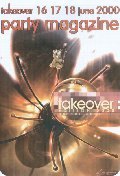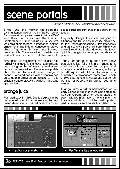Scene papermags & TO00 party magazine
A Bookwormish Prophet of Hugi
Diskmags, online magazines and plain-text newsletters are the major
examples of Scene Journalism, but there are also a couple of
conventional paper magazines. They are few in number, for their creation
costs a lot more than what has to be afforded for electronical
magazines, and they are pretty hard to spread. Yet there have been some
scene mags developed using Gutenberg's printing press. One example is
Hope, a late project of Medicus of KLF & Beans, who had been a
well known swapper in the PC scene of the early 90s. The mag was in
black/white, had quite a few hand-painted illustrations and was spread
at parties and via mail. Of course it cost money: you had to send
Medicus 2 DM, which was then equal to about 1.5 US$, to get back your
issue. Only in this way could he compensate the costs for printing and
stamps.
Although the mag was also advertised and offered by Zyklop Mailorder
(the producers of the Hot Scene Stuff and Scene 96 CDs), it wasn't
widely spread, for obvious reasons. The fact is, with electronic
magazines you can reach much more people than with papermags for a
cheaper price, and you can offer more contents, for less trouble with
printing and spreading. It isn't much of a surprise that Hope stopped
releasing in 1998 after only two issues. Despite all this, people like
Medicus definitely deserve respect for having had the energy to produce
and spread a magazine at pretty high costs and the risk that they would
not get all the money back they had invested in the making of the mag.
The audience of such magazines may be rather limited, but everybody who
has a copy of a scene papermag can be proud of it. It's a rare example
of extraordinary scene culture.
What makes scenish papermags so special, what distinguishes them both
from commercial papermags and scenish electronic magazines? Apart from
the expenses, it's mainly the layout: hand-painted graphics from pixel
artists and sceners who usually don't draw using their computers,
printouts of what was only to be seen on your PC screen before, crazy
fonts, headline styles and footnotes, plus simply the fact that you can
not only look at or listen to something the demoscene produced, but also
feel it - you can feel the scene. It's a bit like getting a
letter of a mailswapping contact, opening it, finding disks and possibly
cards, pages from newspapers or drawings your swap partner created or
which he passed on from another of his swapping contacts. Of course
scene papermags are not quite as personal as selfmade "hardware" you get
from a penpal of yours, but they give you the feeling that the scene is
not something entirely virtual, but exists in the immediate physical
world.
The Takeover 2000 party magazine
 For three years, the Takeover party organizers have provided their
visitors with free booklets (their price was partly included in the
entry fee and partly covered by the sponsors). Its original purpose
was to inform the visitors about compo deadlines, rules, how to set
up the network connection and the like. In the past year a couple of
general scene-related articles have been added, such as an interview with
Bjorn Lynne.
For three years, the Takeover party organizers have provided their
visitors with free booklets (their price was partly included in the
entry fee and partly covered by the sponsors). Its original purpose
was to inform the visitors about compo deadlines, rules, how to set
up the network connection and the like. In the past year a couple of
general scene-related articles have been added, such as an interview with
Bjorn Lynne.
With this year's edition of Takeover, which was held in June, the booklet
has now evolved to a "party magazine". With 52 DIN-A5 pages, including
the coloured cover, it is more than 18% larger than last year's booklet.
Only two pages are occupied with adverts for the Dutch searchengine
track.nl, one of the party's main sponsors, and three pages have been
left blank (one of them, however, contains the text: "this page is left
intentially not blank"). The remaining space is occupied by party
information and articles!
The texts cover almost the whole spectrum of the scene: coding, music,
and graphics, although they are not too technical, so everybody
interested in any field of demos can follow them. The "coding" article,
written by JAL of Nostalgia, is one of the endless complaints about the
decay of coders' habits - that they don't fully explore graphic cards
and don't optimize their code and so on. The "music" article is an intro
to chiptunes by "Mr. chiptune.com" Rez, and the "graphic" article is
Wade's The ART of computer gfx, which
you can also read in this Hugi issue. An interview with both The REW,
Takeover main organizer, and Yes, LTP main organizer, is also included -
it deals with party organizing, of course. Furthermore, I contributed my
guide on Scene Portals from Hugi 19, just so that the people at the
party could use the broadband network connection appropriately even if
they didn't have Hugi at their hands right at the moment.
 The layout of this papermag is much like last year's booklet: two
columns, Arial font, justified text. Pretty cool is the design of the
headlines on each page, with the name of the author below in italic
font. The funniest thing about this mag, however, is the field at the
bottom of each page next to the page number. Here you learn highly
interesting facts such as "Bats always turn Left when exiting a Cave"
or "The US has never lost a War in which Mules were used". It's really
fun reading these lines and you occasionally learn things you had not
known before.
The layout of this papermag is much like last year's booklet: two
columns, Arial font, justified text. Pretty cool is the design of the
headlines on each page, with the name of the author below in italic
font. The funniest thing about this mag, however, is the field at the
bottom of each page next to the page number. Here you learn highly
interesting facts such as "Bats always turn Left when exiting a Cave"
or "The US has never lost a War in which Mules were used". It's really
fun reading these lines and you occasionally learn things you had not
known before.
The mag is also rich of illustrations. Two full-screen, erm, full-page
pics by Druid and Unreal are in the mag, and the front cover has been
painted by Made.
The print-run was 600. That was higher than the numbers of visitors at TO00, so some copies have remained. Maybe you'll be able to get one of these rare goods at next year's Takeover - plus the new mag, of course!
Adok/Hugi - 20 Jul 2000
 For three years, the Takeover party organizers have provided their
visitors with free booklets (their price was partly included in the
entry fee and partly covered by the sponsors). Its original purpose
was to inform the visitors about compo deadlines, rules, how to set
up the network connection and the like. In the past year a couple of
general scene-related articles have been added, such as an interview with
Bjorn Lynne.
For three years, the Takeover party organizers have provided their
visitors with free booklets (their price was partly included in the
entry fee and partly covered by the sponsors). Its original purpose
was to inform the visitors about compo deadlines, rules, how to set
up the network connection and the like. In the past year a couple of
general scene-related articles have been added, such as an interview with
Bjorn Lynne.
 The layout of this papermag is much like last year's booklet: two
columns, Arial font, justified text. Pretty cool is the design of the
headlines on each page, with the name of the author below in italic
font. The funniest thing about this mag, however, is the field at the
bottom of each page next to the page number. Here you learn highly
interesting facts such as "Bats always turn Left when exiting a Cave"
or "The US has never lost a War in which Mules were used". It's really
fun reading these lines and you occasionally learn things you had not
known before.
The layout of this papermag is much like last year's booklet: two
columns, Arial font, justified text. Pretty cool is the design of the
headlines on each page, with the name of the author below in italic
font. The funniest thing about this mag, however, is the field at the
bottom of each page next to the page number. Here you learn highly
interesting facts such as "Bats always turn Left when exiting a Cave"
or "The US has never lost a War in which Mules were used". It's really
fun reading these lines and you occasionally learn things you had not
known before.